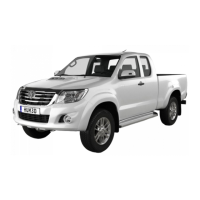Do you have a question about the Toyota 2015 4Runner and is the answer not in the manual?
Covers essential safety practices before driving, including seat belts and child restraints.
Explains the engine immobilizer system and alarm features to prevent vehicle theft.
Details various warning lights and indicators on the instrument cluster and center panel.
Explains the function and display of vehicle gauges like tachometer, speedometer, and fuel gauge.
Describes the display contents for driving data, warning messages, and system information.
Provides information on vehicle keys, wireless remote control, and smart key system functions.
Covers operation of smart key system, wireless remote control, door locks, and automatic door systems.
Details procedures for adjusting front, rear, and third-row seats, including head restraints and memory functions.
Explains how to adjust the steering wheel and mirrors for optimal driving position.
Covers operation of power windows, power back window, and moon roof, including jam protection.
Illustrates and describes exterior parts like doors, mirrors, wipers, fuel filler, and all exterior lights.
Details components on the instrument panel, including switches, meters, and displays.
Shows and describes switches on the steering wheel and dashboard for various functions.
Identifies interior features such as airbags, seats, restraints, storage, and lighting.
Covers essential pre-driving checks, starting and stopping procedures, and parking.
Details engine start/stop procedures, automatic transmission operation, and turn signal usage.
Explains operation of headlights, fog lights, and windshield wipers/washers.
Covers cruise control, intuitive parking assist, 4WD systems, traction control, and other driving aids.
Explains manual and automatic air conditioning controls, defogging, and air outlet adjustments.
Details the interior lighting list, including front, rear, personal lights, and illuminated entry system.
Covers various storage compartments like glove box, console box, cup holders, and luggage compartment features.
Describes sun visors, vanity mirrors, clock, power outlets, armrest, assist grips, and garage door opener.
Provides guidance on cleaning and protecting the vehicle's exterior and interior.
Outlines maintenance requirements, general maintenance, scheduled maintenance, and emission inspection programs.
Offers step-by-step instructions for common maintenance tasks like checking fluids, tires, and replacing bulbs/fuses.
Covers essential information for emergencies, including hazard flashers and stopping the vehicle.
Provides detailed procedures for towing, dealing with engine issues, warning lights, flat tires, and battery problems.
Lists detailed vehicle specifications, dimensions, weights, engine, fuel, and tire information.
Explains how to customize various electronic features like smart key system, power windows, and lighting.
Details items that need initialization after maintenance or battery reconnection.
Provides information on reporting safety defects to NHTSA and Toyota Motor Sales.
French explanation of seat belt usage and maintenance.
French explanation of SRS airbag system components and precautions.
| Brand | Toyota |
|---|---|
| Model | 2015 4Runner |
| Category | Automobile |
| Language | English |












